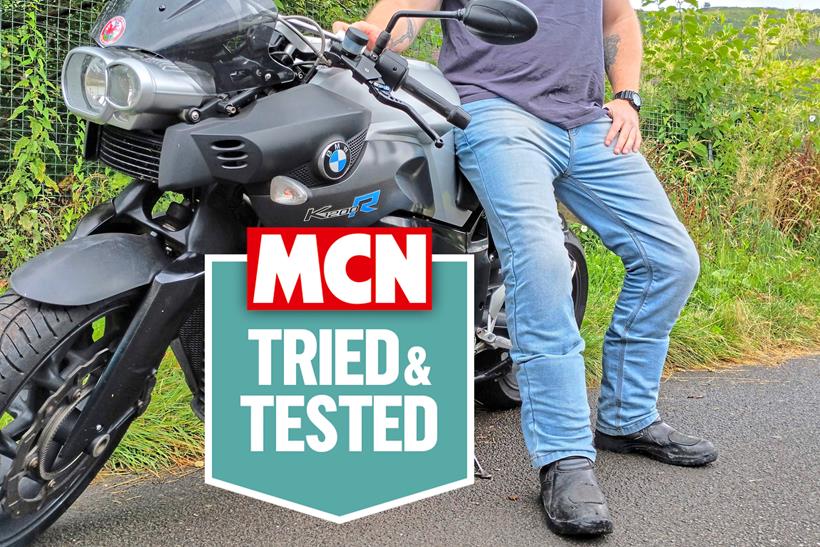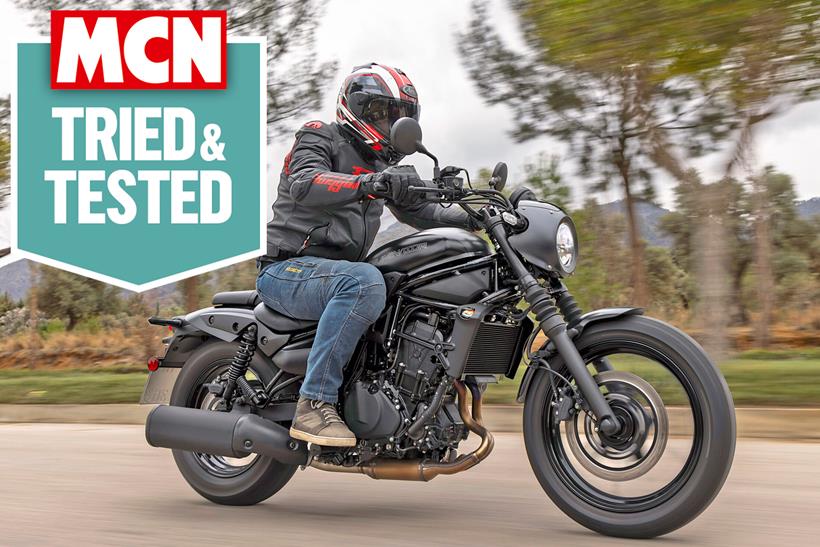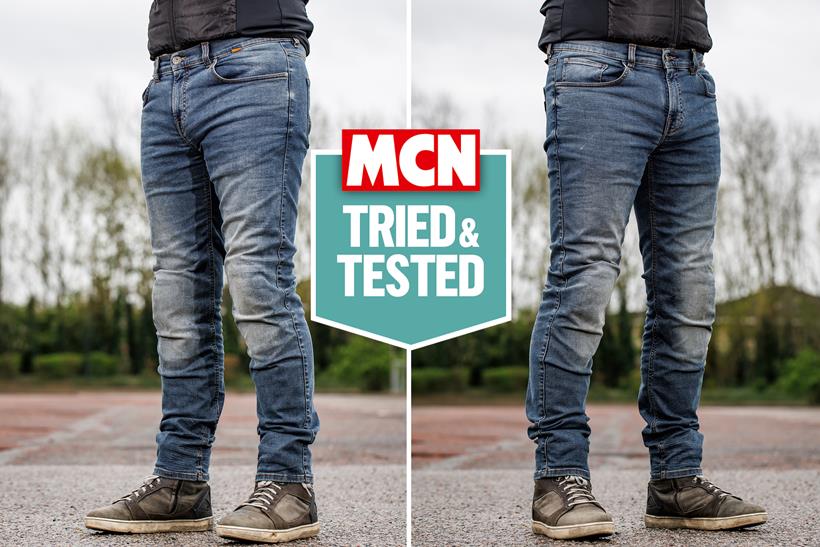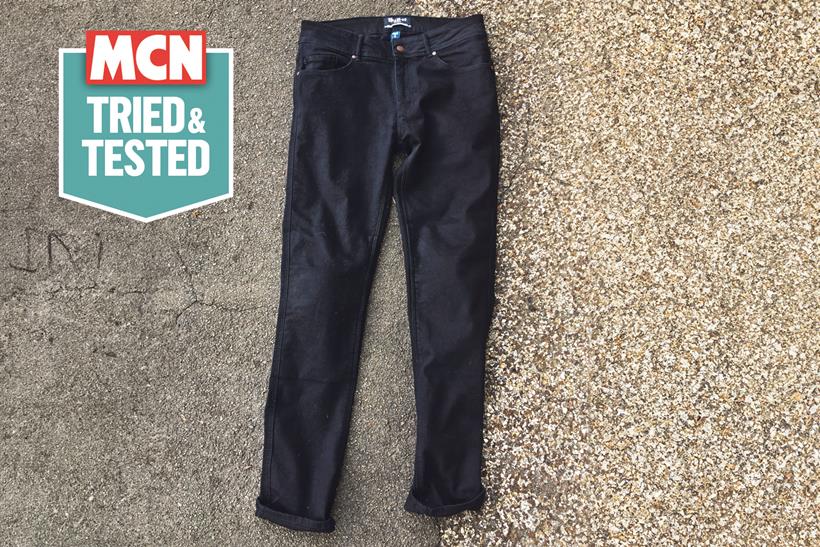Best AA rated motorbike jeans | A happy middle-ground of comfort and protection

Comfort while riding your motorbike is important, if we are uncomfortable we are distracted, and as we know distraction is never good when on a bike. Motorbike jeans have become more protective and comfortable to solve this issue.
The safety and protection of motorbike clothing is measured with a CE certification from A to AAA with A being the lowest level and AAA jeans being the highest level of abrasion and impact resistance. The armour will also have a CE rating of either level 1 or level 2, level 2 offers a higher impact absorption than that of level 1. It is important to be aware of these when looking for a pair of motorcycle jeans.
You may also want to consider the fit and cut of the jeans you require as the type of motorcycle boots that you like to wear. You will need to able to either tuck the jeans in or pull the jean leg over the top of the boots, to avoid uncomfortable rucking of the fabric.
We have pulled together a list of some of our favourite AA rated jeans, tried and tested by the team at MCN.
Jump to:
The best AA rated motorcycle jeans


"Budget is always a consideration when buying riding gear. If I had to spend my own money on the Tyrian jeans, I think it would be money well spent. The jeans are set to serve your riding career well and will be the perfect a compliment to your riding adventures. Sometimes, spending a little more for a great fit and quality product is worth it, and these definitely are."
Read our full Roadskin Tyrian Jeans review
Pros
- Great length and cut, figure fitting but roomy
- Enough leg room to get them over a boot, but not too much that you couldn’t tuck them in if you wanted too
- Good amount of elastic comfort and manoeuvrability
- Decent pocket depth for modern phones
- Hard wearing – thick denim and reinforced stitching
- Stealth look – not easily recognisable as riding jeans
- Luxury premium feel, from the point of receiving them, opening them up, and trying them on for the first time
- Decent overlaps on the armour pocket holders so you don’t get a foot caught as you are pulling them on
- CE level armour is highly malleable and is supply enough to move with you and leave in, without being intrusive, abrasing or annoying when off the bike
Cons
- When pulling the jeans over the boot you may find the inside liner gets stuck as it hangs and isn’t stitched in
- Lighter colours do tend to mark easier, but that can be said for any jean or item of clothing
- Any exposed Velcro of boots that are placed inside the trouser quickly deteriorate the inner when caught, as threads start to get pulled due to the Velcro’s abrasiveness
| Construction | Reinforced stitching, with a blend of 75% CORDURA denim, polyester, nylon and Lycra |
| Type | Single layer riding jeans |
| CE Rating | AA |
| Armour | Hip and Knee Level 2 armour |
- Triple stitched seams
- Cool mesh lining
- Adjustable length, shorter mesh lining so they can be turned up
- Double belt loops to attach top layers
- Classic five pocket design


"These jeans have been my go to for good reason, I can easily spend hours wearing them without really being aware that I’m not in normal jeans. They look so much like regular jeans that you don’t look out of place anywhere when you are off the bike, making them so usable.
"The only thing as mentioned above that I would change about these jeans is the AA safety rating. Make them AAA and they would be as close to perfect as ladies motorcycle jeans can get for me."
Read our full Bull-it Heron Ladies Jeans review
Pros
- They are incredibly comfortable
- Very good quality - will last for years and years of riding
- Look like normal jeans
- The fit is nice and flattering, and true to size
Cons
- You can get AAA rated jeans for similar money
| Construction | Single layer |
| CE rating | AA |
| Armour | Level 1 knee and hip |
- Mid-rise fit
- High-vis reflective tape to aid in low light conditions
- Twin silver shank, rivets and YKK zip
- Classic five pocket design
- Three leg length options


"The Trilobite Parado jeans are something a little different to the mainstream, and in terms of functionality and comfort score full marks. The look won’t be to everyone’s taste, but if you think of them as an alternative to textile or leather jeans, rather than bike kit in disguise, they can certainly hold their own.
"Having worn them for thousands of miles I would happily spend my own money on them, or better still throw in a few extra quid and trade up to the new CE AAA version, offering a higher level of protection."
Read our full Trilobite Parado Jeans review
Pros
- Flexible panels offer great comfort
- Good ventilation and highly breathable
- Technical hybrid styling
Cons
- Kevlar reinforcement only at impact points
| Construction | 11.5 oz Elastic Denim (98% Cotton, 2% Elastane) with Kevlar lining in knees and seat |
| Type | Single layer with protection in key impact areas |
| CE rating | AA |
| Armour | Level 2 hip and knee |
- Stretch panels in knees, back waist, and crotch
- Adjustable height of knee protectors
- Double belt loops in front, and raised waist belt at the back
- Thighs air vent pockets
- Breathable crotch panel


"With regular high street looks and a good level of protection, these Richa Original 2 jeans are
a great example of what a practical riding jean should be. If I’m going casual, be it to the office, a social gathering or relaxed rideout with mates, I want something comfortable that won’t stand out as motorcycle kit, and these absolutely fit the bill.
"I do love these jeans, and although they may not get a full five stars, for a compromise between comfort, protection and low profile looks they’re something that I’ll keep wearing and would have no qualms about spending my own money on."
Read our full Richa Original 2 Jeans review
Pros
- Just as comfortable as a pair of Levi's
- Well cut
- The faded, aged style really does look great
- Armour is lightweight
Cons
- You could get AAA rated jeans for the same price or less
| Construction | Single layer, 69% cotton, 30% Cordura, 1% Elastane |
| Type | Jeans |
| CE rating garment | AA |
| Armour | CE Level 1 D30 Ghost, hip and knee |
- Single layer
- Five pockets
- Slim cut
- Adjustable knee armour


"If I was in the market for a pair of traditional styled jeans, these would be a pair would be a serious contender. I’m aware that sizing is a very personal thing but for me, these fitted well and have been comfortable from the off.
"Whether I’d look to wear them on warmer days, probably not, as they are heavyweight but that does offer peace of mind when riding."
Read our full Bull-it Coyote Ladies Jeans review
Pros
- True-to-size fitting with accurate sizing for ladies' (size 12 label fits perfectly)
- Available in various leg lengths
- Zips at the ankles for easy fitting over boots
- High waist ensures no gap between jeans and jacket
- Concertina-style knee panels add comfort on any bike
- Look stylish on and off the bike, with a flattering high waistband
Cons
- Hip armour sometimes folds up and doesn't sit comfortably
- Heavy gauge denim can be too hot for summer rides
- Knee armor is soft and only CE Level 1 rated
| Construction | Covec denim |
| Type | Combat style jean |
| CE Rating | AA |
| Armour | Level 1 hip and knee |
- Large patch thigh and bum pockets
- Zips at ankles
- YKK zip
- Mid rise


"Casual but protective is the name of the game with these slim-fit Bull-it jeans. The single-layer fabric meets the CE AA standard for abrasion resistance and there is hip and knee armour included.
Naturally it makes sense to stick the armour in – it does alter the look slightly but doesn’t wreck the styling (and you’ll feel like a twit if you crash without the armour in place). Plus, the stretchy fabric does a decent job of keeping the armour in position.
As with other jeans in the range, these are shower-resistant and the zip is a quality YKK item. The waist is higher than on fashion jeans, but that does prevent gaps between the jeans and your jacket. Sizes are 28- 40 in three leg lengths – the website has a handy measuring guide. The jet black colour looks great when they are squeaky clean, but be aware that they show up insect splats more than blue jeans."
Pros
- Casual feel and look
- Armour fits in place as it should
- Shower resistant
| Construction | Tactical Oneskin outer shell with premium Covec stretch recovery yarns |
| Type | Jeans |
| CE rating | AA |
| Armour | Level 2 hip and knee |
- Water resistant finish
- Adjustable pockets for armour
- Stretch denim
- AA rated
FAQ’s
What does single layer mean?
Generally, motorcycle riding jeans can either be single layer, where the abrasion-resistant material is woven directly into the outer layer; or they can be formed in a regular cotton denim outer with a separate inner lining formed in the abrasion-resistant material, usually aramid fibres or materials like Kevlar, for example.
How are motorcycle jeans tested?
Riding jeans classed as PPE (Personal Protective Equipment) earn certification by being subjected to a range of tests under the standard for motorcycle clothing of EN 17092. These tests include:
Impact energy absorption
This covers the impact protectors fitted, which are mandatory in class AAA and AA garments for shoulder, elbow, knee and hip. Hip protectors are optional for class A. Protectors must cover the appropriate body part and be certified to EN 1621. There are two classes for protectors, level 1 and 2, with the latter offering greater performance.
Impact abrasion resistance
This test measures how well a garment performs when worn by an average rider (weighing 75kg and measuring 1.7m tall) in a slide. Three samples of the same garment are mounted in a rotating rig at different angles and impacted on an asphalt surface at a prescribed speed. They’re allowed to come to a natural stop before being measured. If the samples do not hole, they’re subjected to this twice more, and to pass there must be no hole bigger than 5mm.
Seam strength and structural closures
All seams, including those of the protector pockets, and zip fasteners are subjected to this test (EN 13594) to ensure that they have sufficient resistance to being torn apart.
Tear strength
A number of samples are taken from the garment to measure their resistance to further tearing once they have been split.
Dimensional stability
To ensure that a garment is not affected by through washing, it is subjected to five separate controlled washing cycles. Any fixed armour must remain in place and the garment must not shrink any further than 5% during the process.
Innocuousness
In order to make sure that the garment is safe to wear against the skin in normal use, this test covers the chemicals and dyes used in the production process that remain in the fabric.
Fit and ergonomics
The garment is tested by an assessor to ensure that the necessary range of movements can be carried out for the application and that the fit tallies with the manufacturers size guide.
Classification
Assuming a garment achieves a pass in all tests, classification is awarded according to the performance level as follows:
AAA (EN 17092-2:2020) – The highest achievable for abrasion resistance.
AA (EN 17092-3:2020) – A lower pass for abrasion resistance.
A (EN 17092-4:2020) – The lowest classification for abrasion resistance.
B (EN 17092-5:2020) – This is for garments which have no impact protection but do offer abrasion resistance.
C (EN 17092-6:2020) – For garments offering solely impact protection without abrasion resistance, such as armoured shorts or vests designed to be worn as a base layer.
How we test AA motorcycle jeans
At MCN, our team of expert journalists have decades of experience gained over hundreds of thousands of miles in order to provide you with opinions and evaluations you can trust, alongside news of the most significant developments in motorcycling safety gear. We want you to stay safe, enjoy your riding and hopefully look great while doing so!
We don’t test our kit to destruction; we use it exactly how you do, in the real world and in all conditions.
That means we can deliver impartial buying advice you can rely on. To make it onto this list, AA jeans must have been worn for hundreds or thousands of miles by our team of experienced testers, show no major flaws, and meet modern safety standards as well as offering decent value for money.
Each of our expert reviewers tests their jeans for a variety of things, both subjective and objective. Factors assessed include the level of safety rating, what armour is fitted, how breathable they are, do they look good and do they have any additional features like waterproofing.
However, we also assess how they fit, their perceived quality, how we feel wearing them and how comfortable they are both on and off the bike.
We cover thousands of miles in these trousers and regularly compare them with one another in the office, so collectively we’ve built the sort of knowledge base you can trust.
If you can’t see a review against a pair of AA jeans on this page, it’s because we haven’t tested them yet. These will only be included if we think they’re important and relevant in the market, and rest assured, we will be working on bringing you a review as soon as we’ve done the miles.
Here’s a brief run-down of the star rating system we use, and what each score means:
- 1 star – Poor performance in this category or overall. A helmet with a single star rating has fallen below the expected standard and should be avoided.
- 2 stars – Basic performance in this area or overall. A helmet with a two-star rating has managed to perform to a barely acceptable level and there is room for improvement. It might be lacking safety features, be poorly built or far too expensive to recommend.
- 3 stars – An average performance in this area or overall. A helmet with a three-star rating has achieved a basic level of performance and is deemed adequate.
- 4 stars – A product has performed over and above the accepted averaged in this category or overall. A helmet with a four-star rating has surpassed expectation and delivered in a particularly impressive way.
- 5 stars – A helmet has performed at the highest possible level in a particular category or overall. A product with a five-star rating has delivered to the highest possible level, impressing the tester with its performance. We would happily spend our own money on it.
To find out more about our kit testing, head to our dedicated page explaining how we test motorcycle products.
- Just so you know, we may receive a commission or other compensation from the links on this website - read why you should trust us.






